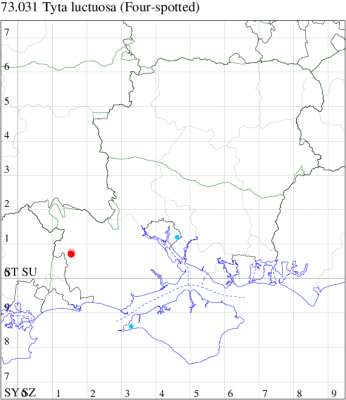2020 Annual Report for: Noctuidae / Aediinae
For species seen in 2020 that had less than or equal to 100 records, full details are included; for more common species, the earliest, latest and highest count by vice-county are shown. The narrative for each species is taken from the main Hantsmoths website, and it is possible that some information on abundance and occurrence can get out of date, as it is impossible to keep up with all changes; however it should give a good introduction to each species. The tables in each species account summarise the previous status, and that for the current year.
For the maps, all records prior to 2020 are shown by a blue dot (the larger the dot, the more recent), with the current year's records shown in red. As previous records are superimposed on any report for 2020, new sites have greater emphasis (i.e. will show as 'more red').
In the species accounts, an asterisk next to a location indicates a new 10km square record; earliest ever dates are highlighted in orange, and latest ever in red. Initials in the species accounts refer to the recorders listed here. Please get in touch if you identify any omissions or errors, in particular if you have records that have yet to be submitted. Details of how to submit records can be found here.
73.031 [B&F: 2465] Four-spotted Tyta luctuosa ([Denis & Schiffermüller], 1775) - Nationally Rare
Nationally scarce (Na) in dry open areas, south-facing hillsides, unimproved grassland, embankments and waste ground in southern England, a priority species under the UK Biodiversity Action Plan. Restricted nowadays to a handful of locations, near Peterborough, Cambridgeshire, at Portland, Dorset and at single sites in Lincolnshire, Essex, Leicestershire and Northamptonshire. Occasional migrants turn up some distance from know breeding sites, these are presumed to have originated from mainland Europe. In Hampshire the species has disappeared altogether: in the 1950s, it was locally fairly common on downland in a wide area around Winchester. On the Isle of Wight, occasional migrants continue to turn up, the most recent of which was at Totland in August 2004. Wingspan 25-29 mm. Larva feeds on Field Bindweed, over-wintering as a pupa.
Records prior to 2020
| Vice County | #Records | #Individuals | First Record | Last Record |
|---|---|---|---|---|
| 10 | 13 | 6 | 1800 | 2004 |
| 11 | 17 | 9 | 1800 | 2004 |
| 12 | 10 | 4 | 1800 | 1951 |
2020 records
| Vice County | #Records | #Individuals | Max Quantity |
|---|

Records by year
Records by week (adult)
Records by week (larval)
Record Details
VC11: Blashford*, one, 31 Jul; one, 31 Jul (JCa&SW)
()().jpg)